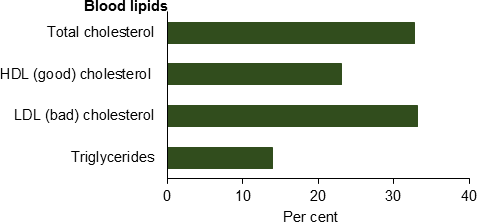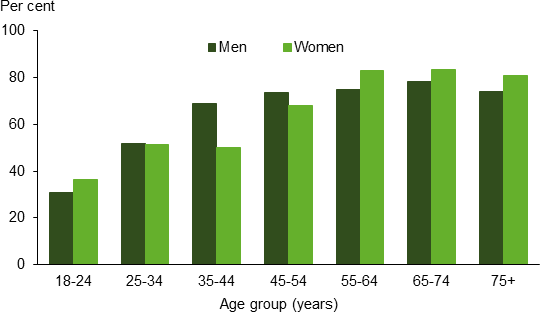Abnormal blood lipids (dyslipidaemia)
Blood lipids are fats in the blood and include cholesterol and triglycerides. Cholesterol is a fatty substance produced by the liver and carried by the blood to supply material for cell walls and hormones. Triglycerides play an important role in metabolism as an energy source and in helping to transfer dietary fat throughout the body.
Dyslipidaemia—abnormal blood lipids—can contribute to the development of atherosclerosis, a build up of fatty deposits in the blood vessels which may lead to the development of cardiovascular diseases. Dyslipidaemia is a risk factor for chronic diseases such as coronary heart disease and stroke.
Box 1: How is dyslipidaemia measured?
Blood tests are used to determine levels of the most commonly measured lipids. The standard lipid blood tests include measurements of total cholesterol, low-density lipoprotein cholesterol (LDL, or 'bad' cholesterol), high-density lipoprotein cholesterol (HDL, or 'good' cholesterol), as well as triglycerides.
In the Australian Bureau of Statistics (ABS) 2011–12 Australian Health Survey (AHS), a person was classified as having dyslipidaemia if they had one or more of the following [1]:
- total cholesterol ≥ 5.5 mmol/L
- LDL cholesterol ≥ 3.5 mmol/L
- HDL cholesterol < 1.0 mmol/L for men, and < 1.3 mmol/L for women
- triglycerides ≥ 2.0 mmol/L
- taking lipid-modifying medication.
Who has dyslipidaemia?
Based on measured data from the 2011–12 AHS, almost 2 in 3 people aged 18 and over (63%) have dyslipidaemia. This is comprised of:
- 57% with uncontrolled abnormal blood lipids
- 7% taking some form of lipid-modifying medication but with normal lipid levels.
One in 3 Australian adults (33%) have high levels of LDL (bad) cholesterol, almost 1 in 4 (23%) have low levels of HDL (good) cholesterol and 1 in 7 (14%) have high levels of triglycerides. One in 3 (33%) have a total cholesterol level that is considered high (Figure 1).
Figure 1: Prevalence of dyslipidaemia in persons aged 18 and over, 2011-12

Note: Excludes persons who did not fast for 8 hours or more prior to their blood test.
Source: ABS 2013. Australian Health Survey: biomedical results for chronic diseases, 2011–12. ABS. cat. no. 4364.0.55.005. Canberra: Australian Bureau of Statistics.
Dyslipidaemia is common among both men and women, with rates over 50% for all age groups except those aged 18–24. Rates increase from age 18–24 to 65–74 (Figure 2).
Figure 2: Prevalence of dyslipidaemia in persons aged 18 and over, by sex, 2011–12

Note: Excludes persons who did not fast for 8 hours or more prior to their blood test.
Source: AIHW analysis of unpublished ABS 'Australian Health Survey 2011–12 (National Health Measures Survey Component)' (see source data).
Inequalities
The proportion of the population with dyslipidaemia is relatively similar across geographic areas and socioeconomic groups.
International comparisons
The World Health Organization reported that Australian men and women aged 25 and over had estimated average total cholesterol levels of 5.1 and 5.3 mmol/L respectively in 2009 [2]. This was similar to New Zealand (5.2 mmol/L for both men and women) and Canada (5.1 mmol/L for men and 5.2 mmol/L for women) but lower than in the United Kingdom (5.4 mmol/L for men and 5.5 mmol/L for women). Turkey had the lowest average of 34 OECD countries (Organisation for Economic Cooperation and Development), with total cholesterol of 4.7 mmol/L for both men and for women. The highest average of 5.7 mmol/L was for men and women in Iceland.
Source data
References
- ABS (Australian Bureau of Statistics) 2013. Australian Health Survey: users' guide, 2011–13. ABS cat. no. 4363.0.55.001. Canberra: Australian Bureau of Statistics.
- WHO (World Health Organization) 2014. WHO global health observatory data repository. Mean total cholesterol trends (crude estimate). Data by country. Geneva: World Health Organization. Viewed 11 September 2015.


